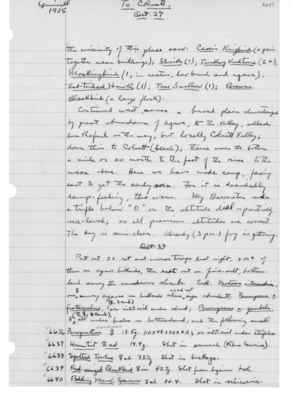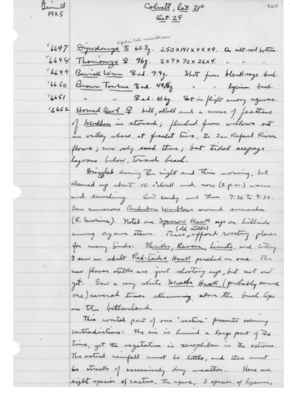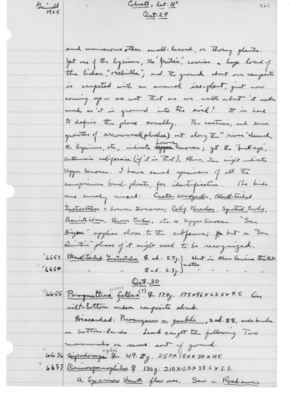Pages
S3 Page 65
Collector: Grinnell - 1925 Location: to Colnett, Date: Oct. 27 Page Number: 2607
the vicinity of this place saw: Cassin Kingbird ( a pair together near buildings); Shrike (1); Turkey Vulture (2+); Mockingbird (1, in cactus, low brush and agave); Red-tailed Hawk (1); Tree Swallow (1); Brewer Blackbird ( a large flock).
Continued west across a broad plain characterized by great abundance of agave, to the valley, called San Rafael on the way, but locally Colnett Valley; down this to Colnett (beach); thence across the bottom a mile or so north to the foot of the rise to the mesa above. Here we have made camp, facing east to get the early sun. For it is decidedly damp-feeling, tho warm. My barometer reads a trifle below "0" on the altitude dial - practically sea-level; so all previous altitudes are correct. The day is semi-clear. Already (3 p.m.) fog is gathering.
Oct. 28 Put out 22 rat and mouse traps last night, 3 or 4 of them on agave hillside, the rest out on fine-silt bottom land among the numerous shrubs. Took: Neotoma intermedia, one (male sign) among agaves on hillside where wood rat sign abundant; Peromyscus c. fraterculus, 1 (female sign, 2 emb.) on silt-soil under shrub; Peromyscus m. gamble , 3 (male, female, female emb. signs), all under bushes on bottomland; and the following small
6636 Perognathus (female sign) 13.5g. 110x48x20x40; on silt -soil under atriplex. 6637 Wren tit (male sign) ad. 14.4g. Shot in sumach (Rhus laurina). 6638 Spotted towhee (female sign) ad. 33.7g Shot in buckeye. 6639 Red-winged Blackbird (female sign) im. 43.7g. Shot from Lycium bush. 6640 Belding Marsh Sparrow (male sign) ad. 20.4. Shot in salicornia.
S3 Page 66
Collector: Grinnell - 1925 Location: to Colnett, Sat. 31 degrees Date: Oct. 28 Page Number: 2608
6641 Savannah Sparrow (female sign) im. 16.7g. Shot in salicornia. 6642 “ “ (female sign) im. 16.8.g. Shot on stem of clump of juncus.
Was out early 5:15 to 6:30, and again 9:20 to 11:30, the last time to the beach, the bluff, and the salt flats. Saw following birds: Turkey Vulture (4+); Poorwill (heard calling last evening); Valley Quail (2 large coveys near camp); Cactus Woodpecker (one heard); Say Phoebe (2); Anna Hummer (2, around blossoming Lycium); Brown Towhee (4+); Spotted Towhee (2); Rufous-crowned Sparrow (2); Intermediate Sparrow (12±); Calif. Thrasher (2, singing); Linnet (6±); Wren-tit (4+); Black-Tailed Gnatcatcher (2); Bewick Wren (2); Red-winged Blackbird (a pair visited camp, and others in small companies in flight out in the valley); Raven (within hearing most of the time); Meadowlark (4 or more, out in salt flat); Marsh Wren (common, a dozen or more, in dense mats of Salicornia (unknown 1) sloughs just back of the cobble-stone beach-barrier (which is fully 8 feet higher than the flats inland from it)); Savannah Sparrow (scattered troupes on open ground among small bushes back from the salicornia); Belding and Large-billed Sparrows (on salicornia marshes, not many, the latter also on beach at high-tide line of drift); Pipit (flock of 10± on bare alkali flat); Killdeer (one heard - the only wader, where we saw so many on the beach when we were here in September); Song Sparrow (2, in big juncus clumps up the valley from the salicornia. Of mammals, I saw one Jack Rabbit on salt flat and 2 or more Brush Rabbits.
S3 Page 67
Collector: Grinnell - 1925 Location: Colnett, Sat. 31 degrees Date: October 28, 1925 ?Page Number: 2609
on agave hillsides, where they live in closest association with the intermedia wood rats.
6643 Black-Tailed Gnatcatcher (female sign) ad. 5.8g. Shot in artemesia californica (?) bush. 6644 Western Gnatcatcher (male sign) ad. 5.6g. Shot in sumach bush.
Barometer tonight 29.85 inches; warm, muggy; high fog all day. One perspires too freely for comfort. 7 p.m. - Writing by light of of burning agaves- dead ones, of which there are many on the hillside above our camp. Just went the rounds of my traps by flash light - one Perognathus and one Peromyscus, only, so far. Had re-set Dipodomys traps at fresh burrows, but untouched; maybe these rats do not come out so early, altho it was quite dark by 5:30. Saw a Black Phoebe late this evening. The Western Gnatcatcher taken is the only one of that species so far noted here. The Black-Tailed Gnatcatcher is fairly common, but I find them hard to see by reason of their dark colors, much harder than the other species. The black-tails keep nearer the ground, among the dark stems in the thick brush-clumps. They have two kinds of notes, the faint nasal mew, and a louder, repeated che-che-che-che; so I was right (p. 2593).
Oct. 29 Discarded: Peromyscus m. gambeli, (female sign) (4 emb.), 2 small blue pelaged males, all under composite bushes out on bottomland. 6645 Perognathus arenarius (male symbol) 9.7g. 142 x 71 x 20 x 5. Same trap as yesterday’s. 6646 Black-Tailed Gnatcatcher (male symbol) 5.8g. Shot in Rhus laurina bush.
S3 Page 68
Collector: Grinnell - 1925 Location: Colnett, Sat. 31 degrees Date: October 29, 1925 Page Number: 2610
6647 Dipodomys (male sign) 60.3g. 250 x 141 x 42 x 9. On silt-soil bottom. 6648 Thomomys (female sign) 96g. 207 x 70 x 26 x 4. “ “ “ 6649 Bewick Wren (female sign) ad. 9.9g. Shot from black-sage bush. 6650 Brown Towhee (male sign) ad. 44.5g “ “ lycium bush. 6651 “ “ (female sign) ad. 41.6g. Shot in flight among agaves. 6652 Horned Owl (female sign) bill, skull and a mass of feathers of Mudhen in stomach; flushed from willows out in valley where, at freshet time, the San Rafael River flows; now only sand there; but tidal seepage lagoons below, toward beach.
Drizzled during the night and this morning, but cleared up about 10 o’clock and now (2 p.m.) warm and sunshiny. Out early and then 7:30 to 9:30. Saw numerous Audubon Warblers around sumachs (R. laurina). Noted one Sparrow Hawk up on hillside among agave stems. These (old stalks) afford roosting places for many birds: Shrikes Ravens, Linnets, and today I saw an adult Red-Tailed Hawk perched on one. The new flower stalks are just shooting up, but not out yet. Saw a very white Marsh Hawk (probably same one) several times skimming above the bush tops on the bottomland. The coastal part of our “section” presents seeming contradictions: the air is humid a large part of the time, yet the vegetation is xerophilous in the extreme. The actual rainfall must be little, and there must be streaks of excessively dry weather. Here are eight species of cactus, the agave, 3 species of lycium,
S3 Page 69
Collector: Grinnell - 1925 Location: Colnett, lat. 31 degrees Date: October 29, 1925 Page Number: 2611
and numerous other small-leaved, or thorny plants. Yet one of the lyciums, the “frutéa,” carries a huge load of the lichen, “orchilla”; and the ground about hour campsite is carpeted with an annual ice-plant, just now coming up - so wet that as we walk about it makes mud as it is ground into the soil! It is hard to define the place zonally. The cactus, and dense growths of arrowweed (pluchea) out along the “river” channel, the lyciums, etc., indicate Lower Sonoran; yet the “buck-eye”, artemisia californica (if it is that), Rhus, etc., might indicate Upper Sonoran. I have saved specimens of all the conspicuous bush plants, for identification. The birds are surely mixed: Cactus Woodpecker, Black-Tailed Gnatcatcher = Lower Sonoran; Calif. Thrasher, Spotted Towhee, Bewick Wren, Brown Towhee, etc. = Upper Sonoran. “San Diegan” applies close to the sub fauna; but a “San Quentin” phase of it might need to be recognized.
6653 Black-Tailed Gnatcatcher (female sign) ad. 5.7g. 6654 “ “ (male sign) ad. 6.3g. Shot in Rhus laurina thickets. mates.
Oct. 30 6655 Perognathus fallax (?) (female sign) 17.4g. 175 x 96 x 23.5 x 4.5 On silt-bottom under composite shrub. Discarded: Peromyscus m. gambeli, 2 ad. (male sign) (male sign), under bushes on bottomlands. Lamb caught the following two mammals on same sort of ground. 6656 Dipodomys agilis (female sign) 49.2g. 257 x 150 x 38 x 115. 6657 Ammospermophilus (female sign) 130g. 210 x 53 x 38.5 x 5.5. A Sparrow Hawk flew over. Saw a Roadrunner




